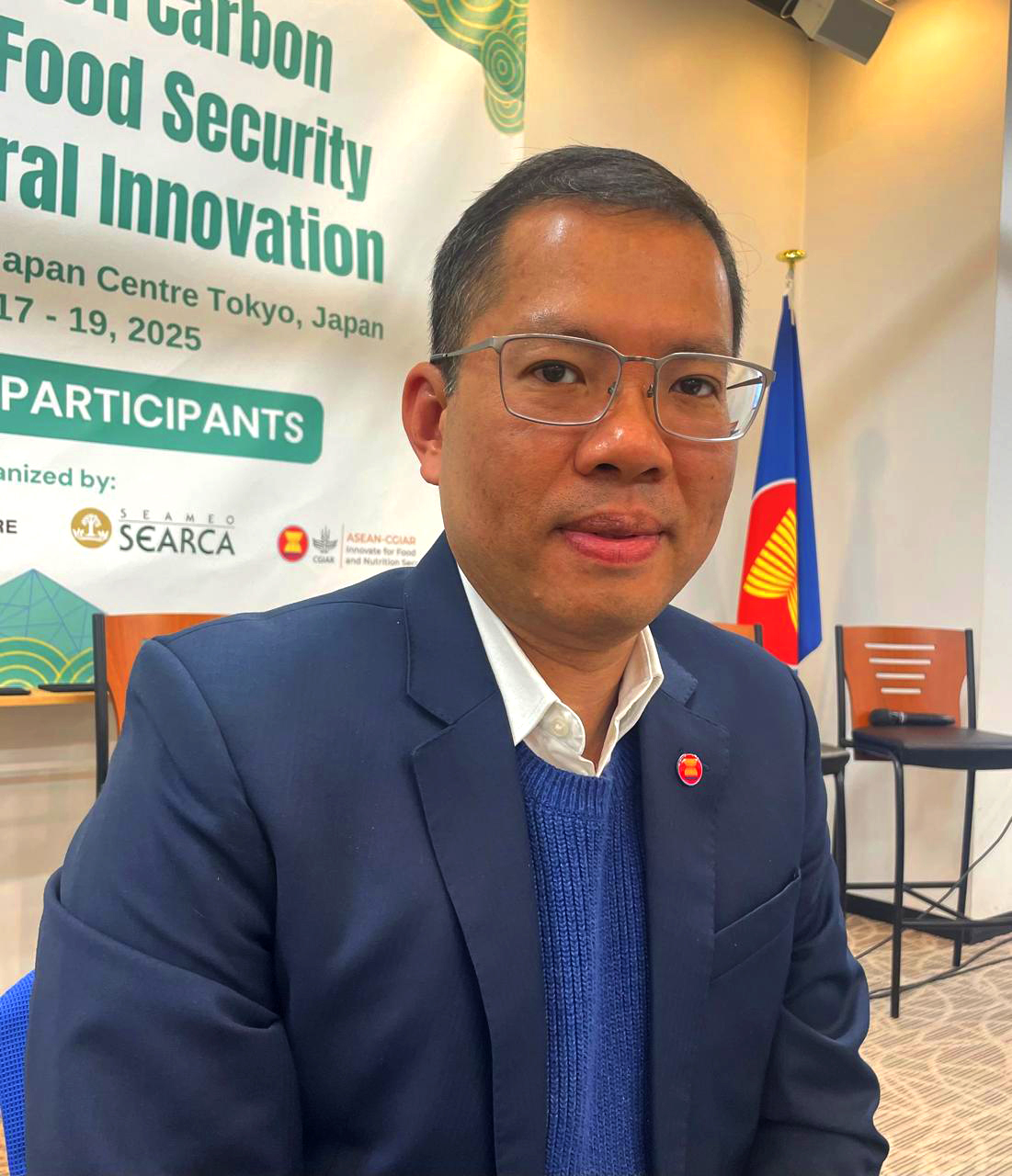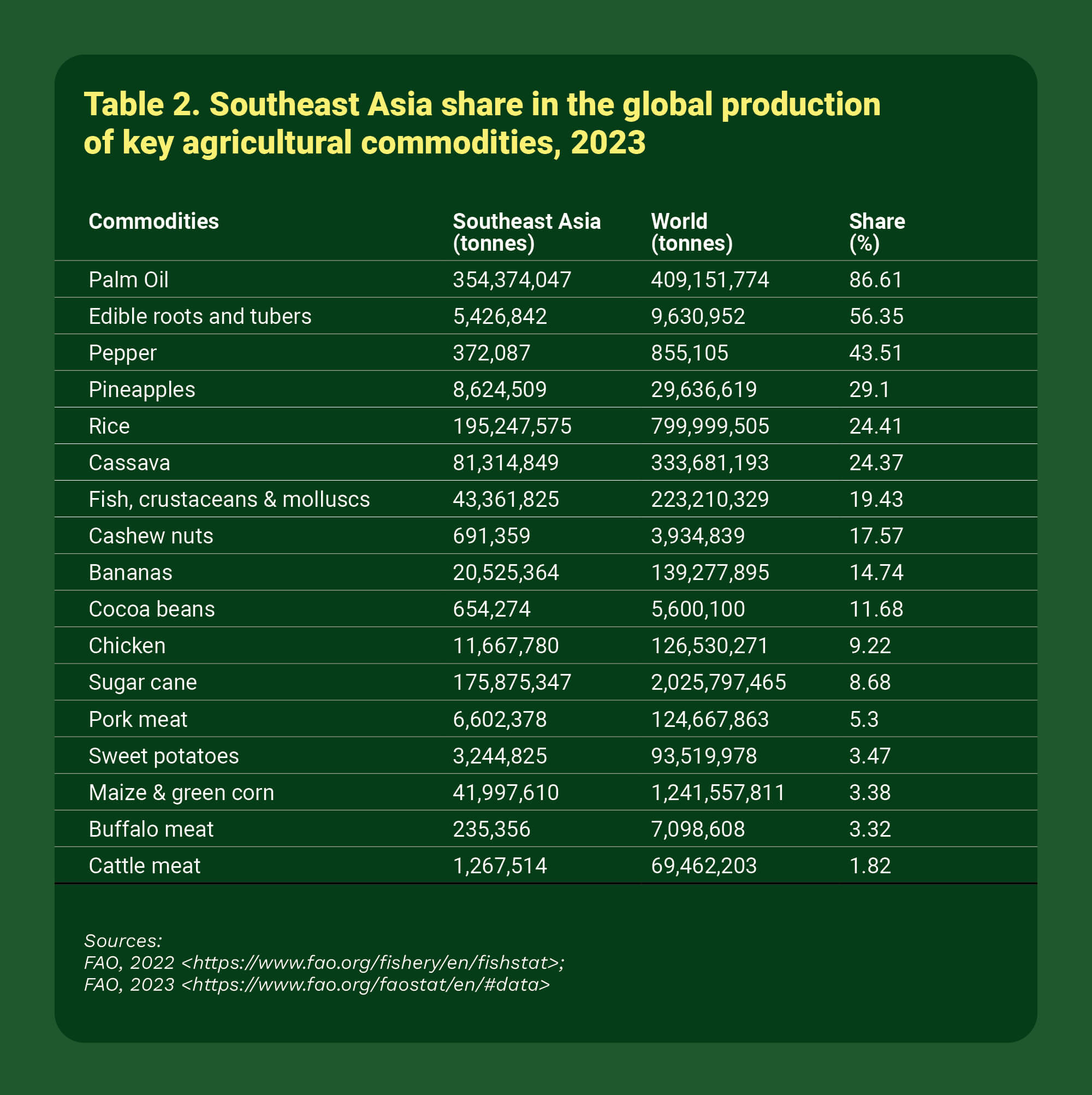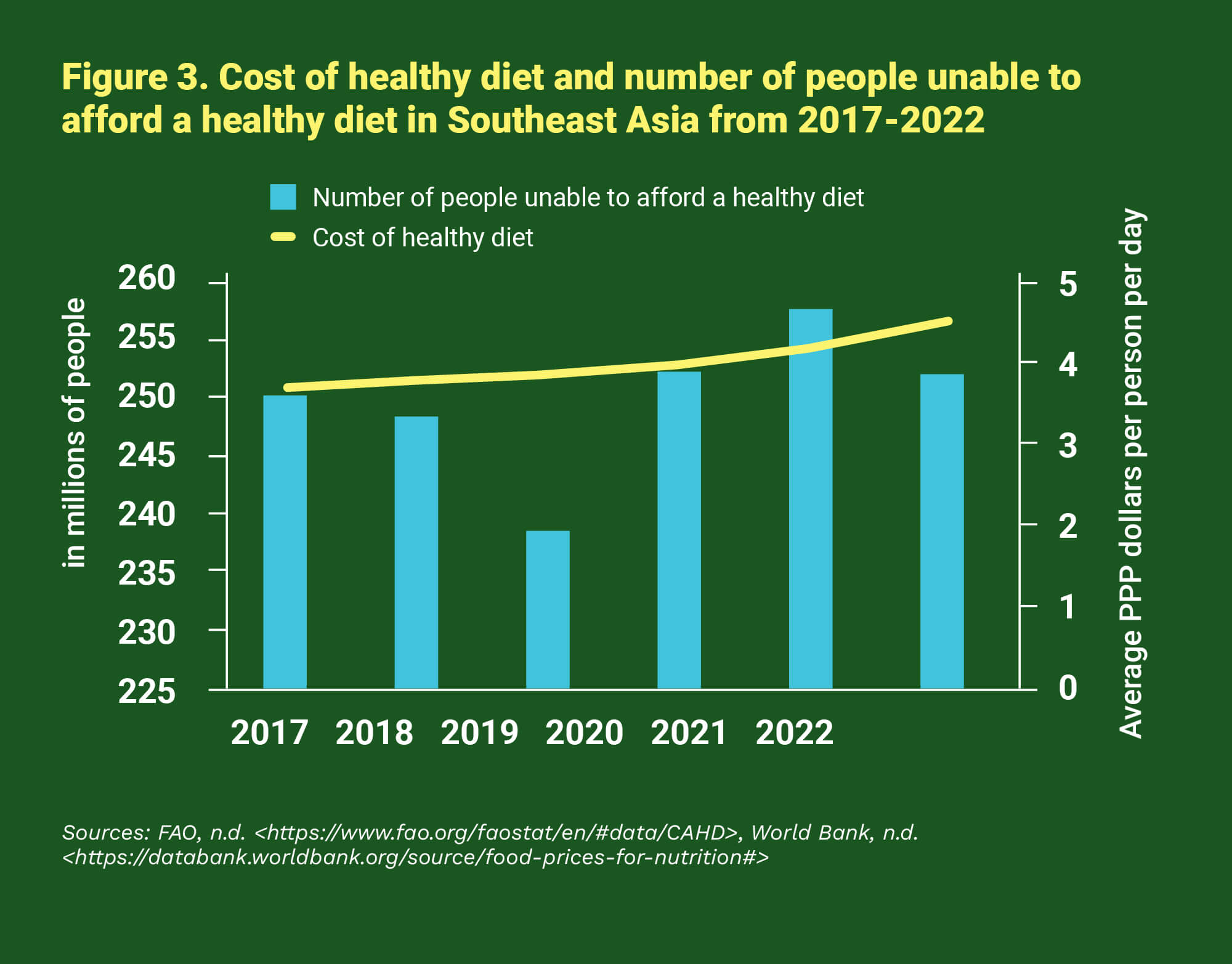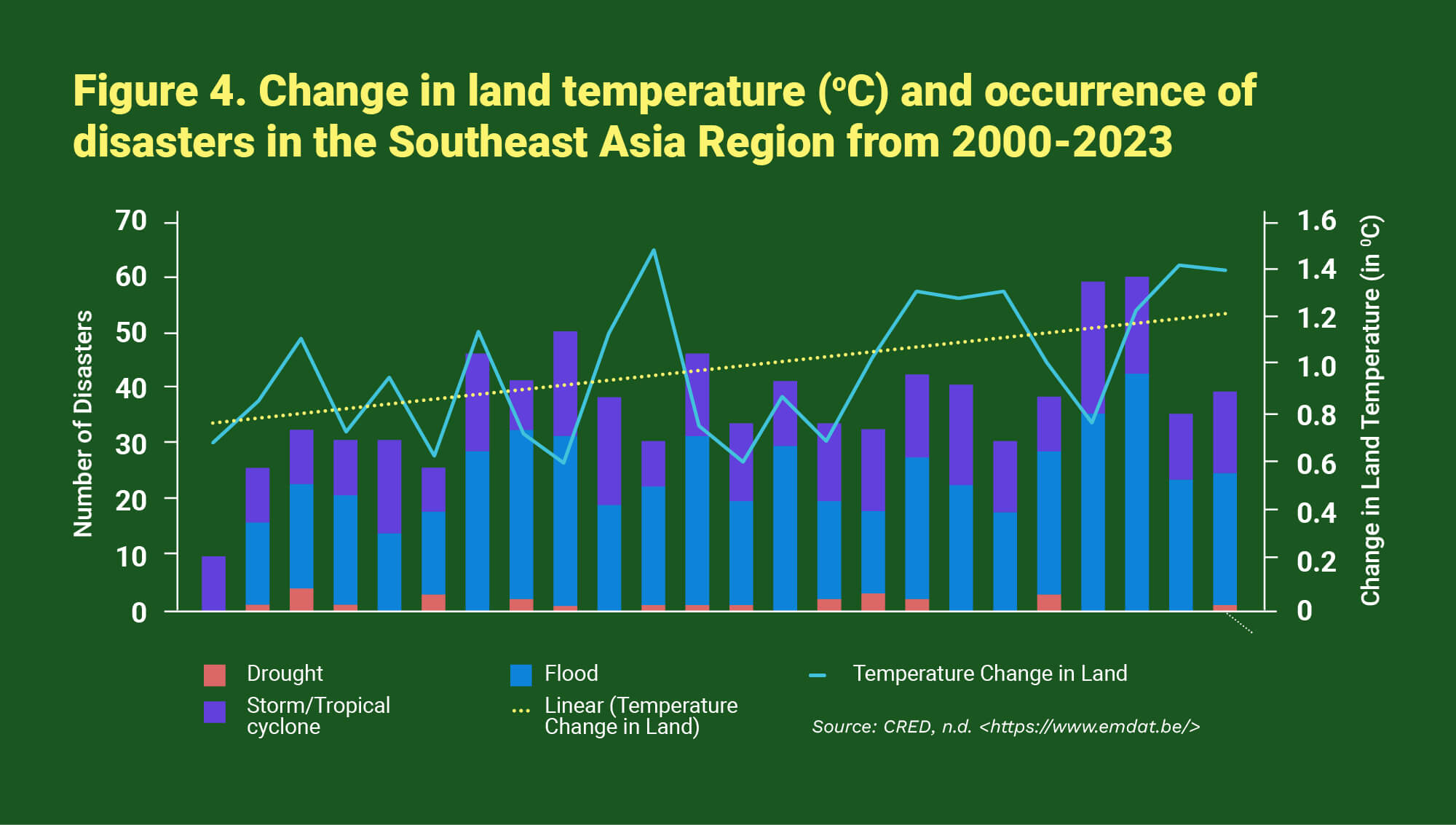






The ASEAN region, while agriculturally abundant, confronts a precarious balance regarding food security. As a major contributor to global food production, the region plays a vital role in improving the availability of food. Despite its agricultural strength, however, millions across ASEAN still face food insecurity, driven by climate change, geopolitical conflicts, and rising food prices. With such recognition, ASEAN's approach over the past decades has been multifaceted, focusing on regional cooperation and innovation to enhance food security. This article explores the evolving landscape of ASEAN’s long-term food security by outlining the challenges, progress, and policies shaping the region’s sustainable future.
Progress in availability, challenges in access
Agriculture remains an important sector for Southeast Asia’s economy, employing over 159 million people in 2021 and accounting for 12.39 per cent of global agricultural employment, according to the Food and Agriculture Organization (FAO). However, its economic contribution varies across the region (Table 1). Agriculture contributes a significant share to the GDP of Cambodia, the Lao PDR, Myanmar, and Timor-Leste, ranging from 16 to 22 per cent. In contrast, it accounts for about 12 per cent in Indonesia and Viet Nam; 8–10 per cent in the Philippines, Thailand, and Malaysia; and less than 2 per cent in Singapore and Brunei Darussalam.

The region is a major player in global agricultural production, particularly palm oil, edible roots, tuber, pepper, pineapples, rice, cassava, fish, crustaceans and molluscs (Table 2). While its global contribution to animal protein—including chicken, pork, buffalo, and cattle meat—is relatively small in volume, this sector has potential for growth and expansion. Between 2014 and 2023, the food supply in the region has improved, with average dietary energy adequacy rising from 117 per cent to 123 per cent (Figure 1). It indicates that food availability has consistently exceeded basic caloric needs, even amidst global disruptions like the COVID-19 pandemic and geopolitical tension.
However, availability alone does not guarantee food security—accessibility, affordability, and nutritional quality are equally important components. Most available food, especially vegetables and fruits, is lost at the farm level. According to the UN Environment Programme’s Food Waste Index Report 2021, wastage and losses are attributed to inadequate harvest time, climatic conditions, harvest, handling and marketing processes.
While food supply has increased, ensuring equitable access to food remains a challenge. As shown in Figure 1, the percentage of people experiencing moderate or severe food insecurity rose from 14.7 per cent in 2014 to 17.1 per cent in 2023, affecting approximately 118 million people. Undernourishment initially declined from 7.8 per cent in 2014 to 5.5 per cent in 2019, but it has since risen slightly to 6.1 per cent in 2023, affecting around 42 million people.
On a more positive note, the region has made significant progress in reducing child malnutrition, with the percentage of children under five who are stunted declining from 29.4 per cent (17 million children) in 2014 to 26.4 per cent (14 million children) in 2022. This improvement is captured in the 2022 Global Food Security Index (GFSI), where ASEAN nations scored an average of 62 out of 100, indicating a moderate to high food security status.


Impact of rising food prices
Food prices in Southeast Asia have seen sharp fluctuations, significantly impacting food security. As shown in Figure 2, food price inflation from 2014 to 2019 remained stable at 1 to 5 per cent. However, the COVID-19 pandemic disrupted this trend, pushing inflation to a 9.3 per cent peak in April 2020. Prices briefly stabilised but surged again, reaching 6.1 per cent in January 2023.
Although food price inflation showed signs of moderation in 2024, it continued to hover between 2.5 per cent and 5.7 per cent, creating financial challenges for households. The rise in food prices disproportionately impacts low-income households, limiting their access to nutritious food. At the same time, farmers face unpredictable earnings because of their lesser ability to invest in better agricultural practices, purchase quality inputs, and sustain their production levels.
In urban areas where economic disparity is growing, food insecurity is visible. Despite the abundance of food choices in major cities, many residents struggle to find affordable and nutritious options. As shown in Figure 3, the cost of maintaining a healthy diet in the ASEAN region increased from an average of 3.54 US dollars per person per day in 2017 to 4.35 US dollars in 2022, measured in current purchasing power parity. As a result, 251 million people were unable to afford a healthy diet in 2022, underscoring the need for targeted policies to improve affordability and nutrition access for all.
Climate change, a growing threat to food security
Southeast Asia is one of the world’s climate-vulnerable regions due to its geography, dependence on natural resources, and dense coastal populations. Since 2010, regional temperatures have risen by 1.3°C to 1.4°C above historical averages, intensifying extreme weather events. Agriculture depends heavily on predictable climatic conditions, but tropical cyclones, prolonged droughts, and floods have become more frequent in the region in recent years, affecting farming activities.
In 2020 and 2021, the occurrences of climate-related disasters in the region peaked at 60 and 61 events (Figure 4). These disruptions affect crop yields, livestock health, and fisheries output, threatening the food supply and the livelihoods of communities that depend on agriculture for their income. The economic cost associated with climate-driven disasters in the region is substantial, with annual agricultural production losses amounting to 20.7 billion US dollars (FAO, 2023).



ASEAN’s commitment to food security and sustainability
ASEAN has exerted tremendous efforts to address food security. Still, ASEAN recognises the need to adapt and deliver innovative responses to the region’s evolving trends and challenges.
Sustainable practices and international collaboration remain crucial for achieving long-term food security and resilience against future crises. In recognition of these opportunities and challenges, the ASEAN Leaders’ Declaration on Strengthening Food Security and Nutrition in Response to Crises was adopted to build a stable, resilient, and sustainable food system by improving agricultural production, trade connectivity, and crisis preparedness.
In the short term, the declaration calls for strengthening local resource-based food reserves, addressing bottlenecks in the availability and affordability of essential farm inputs, and diversifying food production. It also prioritises unimpeded trade and transportation of agri-food products and expanding social welfare and safety net programmes, such as school feeding and emergency food assistance, to ensure vulnerable populations’ access to food.
For long-term resilience, the declaration emphasises investment in agricultural research, accelerates digital transformation and adoption of innovative technologies, and facilitates small-scale farmers’ access to financing. It promotes climate-smart agriculture, sustainable fertiliser production, and initiatives to reduce food waste. Additionally, the declaration highlights the importance of public-private partnerships to drive innovation and investment in sustainable agriculture.
By leveraging its diverse agricultural resources and growing role in the global food market, ASEAN is positioning itself as a food security and sustainability leader. The region’s strong emphasis on inclusivity, innovation, and strategic collaboration ensures that this declaration is more than just policy—it is a transformative blueprint for long-term agricultural resilience, where institutional capabilities and research efforts should be promoted to strengthen food security, ensuring readiness to face global crises such as COVID-19.
Under the ASEAN Community Vision 2025, ASEAN’s focus has been on enhancing cooperation and establishing a foundation for regional collaboration. It has made positive strides through frameworks like the ASEAN Food Security Information System (AFSIS) and the ASEAN Plus Three initiative, which exemplify regional cooperation in areas such as information exchange, agricultural technology, and strategies to mitigate food crises. The ASEAN Integrated Food Security (AIFS), the ASEAN Plus Three Emergency Rice Reserve (APTERR), and the ASEAN Food Security Reserve (AFSR), meanwhile, play a crucial role in stabilising food supply and prices, ensuring food availability during emergencies, and promoting sustainable agricultural practices.
ASEAN Plus Three Emergency Rice Reserve: A food security lifeline in emergencies
The APTERR is an important regional initiative to safeguard food security across ASEAN, China, Japan, and South Korea. This initiative mitigates the impact of natural disasters, economic disruptions, and market volatility through a three-tiered system that ensures rice availability during emergencies. By allowing the collective stockpiling of rice and emergency distribution in times of crisis, APTERR enhances regional resilience (Sundram and Brennan, 2024).
Through robust stockpiles and regional cooperation, APTERR plays a vital role in stabilising food supply chains and protecting vulnerable populations. For instance, in 2023, approximately 3,875 metric tonnes of rice from China, Japan, and the Republic of Korea were donated to Cambodia, the Lao PDR, Myanmar, and the Philippines under the Tier 3 of APTERR. These contributions helped alleviate food insecurity caused by natural disasters while supporting school feeding programmes.
The role of sustainable agriculture in ensuring food security in ASEAN
Sustainable agriculture is vital for ensuring food security in the ASEAN region. By promoting environmentally friendly, economically viable, and socially inclusive practices, the region can manage its resources, such as water and soil, more efficiently towards long-term agricultural productivity. Furthermore, adopting climate-smart techniques and digital technologies and reducing greenhouse gas emissions in sustainable agriculture can mitigate the impacts of climate change, while ensuring resilient food production systems.
In 2024, the ASEAN Ministers on Agriculture and Forestry (AMAF) adopted the Action Plan for Sustainable Agriculture in ASEAN, emphasising the need for supportive policies and frameworks to promote sustainable practices by ensuring effective coordination among stakeholders and contributing to overall food security and environmental sustainability in the region. The benefits of this programme will not only conserve biodiversity through practices like agroforestry and regenerative farming but also promote economically viable production systems that reduce costs and create robust markets for agricultural products. These initiatives will improve rural communities’ livelihoods, ensuring equitable access to nutritious foods.
Moving forward
ASEAN recognises that the concept of food security in the region is evolving in response to various challenges. This transformation emphasises the need for integrated approaches that enhance regional cooperation and resilience. Increasing collaboration between public and private sectors and harnessing research and development can lead to innovative solutions for food production challenges. Post-2025 strategies should focus on enhancing agricultural productivity, ensuring equitable access to food, promoting sustainable farming practices, and building resilience against future crises from local to regional settings. As a vital contribution to long-term food security, these strategies will ensure that agricultural growth benefits all segments of society.








